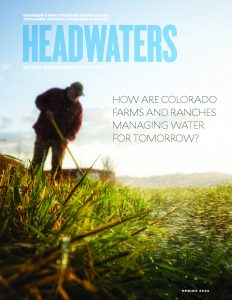Back in the spring, we spoke with Nicholas Colglazier, a member of the Water Education Colorado Board of Trustees and executive director of the Colorado Corn Administrative Committee (CCAC), for the Summer 2022 issue of Headwaters magazine “How Are Colorado Farms and Ranches Managing Water For Tomorrow?” about the challenges facing corn growers and the organization’s work to promote water efficiency improvement measures.
CCAC is the state check-off for corn producers in Colorado, established back in 1987 through a market order to collect a 1.8 cents per bushel assessment on all grain corn grown in Colorado. CCAC uses that funding to conduct research, market development, promotion, outreach and education. That work includes sharing opportunities related to water efficiency soil health and more.
What does your water-related research and work look like?
We’re really looking at how do we help our producers be more efficient? How do we help producers operate with better management practices or best management practices?
And so a lot of that has actually been focused on water in the past. A lot of it has focused on variable rate irrigation or variable rate sprinklers. We’re also looking at, if you’re short on water, when should you irrigate to get the best yield for your crop? So we put some research dollars into that.
We’re really very much invested in how we use this scarce and very important resource efficiently and for the betterment of our industry and environment.
The latest thing we’re doing is we have really dove into soil health because what we see in terms of agriculture is a need for resilience especially as we see the climate changing, whether it’s getting hotter or drier or just hotter will be borne out in the future. But regardless, to be successful you have to be able to manage water and one of those ways is through soil health.
What does soil health mean for producers?
If you can improve your soil health, whether it be through soil structure, organic matter, minimizing erosion from water as well as wind, you build a healthy foundation that you have as an agriculturalist to really be able to make it through harder times.
If you’re able to store more water in your soil, that means that you’ll have a better chance of making a crop in a hotter, dryer year.
If you have better soil structure that means that you have a higher infiltration rate. So when we get a hard rain, which we are notorious for here in Colorado—you know, getting 4 inches of rain in a couple of hours—your field has a better chance of actually absorbing and taking that water into the soil rather than letting it run off and provide no benefit for the future crops.
So we’re really investing heavily with the Colorado Department of Agriculture. We’re part of their soil health initiative and we’re trying to help farmers adopt those conservation practices that will lead to healthier soil and lead to better water retention. And a lot people recognize that this is really what we’re after water retention and healthier soil, so that we can better manage that water here and for future crops.
How are you communicating the importance of soil health out to corn growers?
What we’re trying to do is enroll about seven producers in the STAR+ program. STAR stands for Saving Tomorrow’s Agricultural Resources and it basically awards producers a star level depending upon their practices. So if you are minimizing soil disturbance, if you are building soil armor, if you’re incorporating livestock, if you have plant diversity, if you have a continual live root, these are all things we look for to increase soil health and the microbiome within it. If you’re doing this, you get awarded points.
It’s not like a test where you get answers wrong and they take points away, it is literally an accumulation of points where they look at, “OK, what are you doing? Are you doing your best management practices? Are you adopting good conservation methods? Are you looking out for ways to lessen soil erosion? Are you looking out for ways to lessen your trips across the field and while you’re doing it, lessen the disturbance of that soil so that you can build that soil health?”
And that goes into everything, like soil structure, water infiltration rates, and managing that soil so it can better take in that water resource.
So we’ve been trying to get out there and get a few people to bite.
We have some monetary incentives because these things aren’t cost-free, it takes money to change these practices and buy new equipment, to buy new cover crop seed, you name it. It takes capital investment from our producers and if we can help offset that from the very beginning so that we can learn how things work on farms and get actual practical knowledge and practice on somebody’s farm, it helps flatten that learning curve for the future so that more and more people will be willing to adopt.
So we’re really trying to incentivize producers into this program so that we can get that data and help communicate further to producers to say, you know, doing this is not only beneficial to the environment but it’s beneficial for your bottom line and that sustainability tripod of economics, environment, and social benefits are all there. Without one of them, that whole sustainability table topples right over so were really big believers in that and moving that forward.
What are the biggest challenges that Colorado Corn growers are up against today?
I’d say first and foremost is water availability.
We look at what’s going on, not only just soil health but also in terms of what water’s available and who’s out there buying it. We’ve seen a lot of agricultural operations dry up in the past and we’ve seen a lot of municipalities and people buy farms specifically for the water for later use. So the farm may be using that water now but what is it going to be like in 10, or 15 or 20 years? Are they going to keep that water on the farm or are they going to pull that off for municipal reasons? Keeping water available to farmers is definitely an issue that we see farmers facing down.
Making sure that people who have water have access to it is a big issue, but also making sure the resource is there for the longevity of the industry and community it supports.
Another one is profitability. That is always something that has been an issue within agriculture. It’s a pretty interesting time to talk about it because we’re seeing $8 corn on the board and I just looked at it today in Yuma you can contract, October and November, corn for $7.81 that’s a very, very high price for corn. But we’re also facing questions on the availability of fertilizers and pesticides that are needed to successfully grow a crop. And if you don’t have access to those tools, are you going to be able to grow a crop? Even with $7 corn.
Another issue that we’re constantly trying to figure out is the sustainability of corn. We entered into the soil health arena with the department because we realized sustainability really is a big deal but it’s becoming a much bigger deal outside of our industry. Our customers are the ethanol plants and feed yards, they’re the ones who are selling, ultimately, to the consumer and the consumers are demanding more environmentally conscious sustainability in their products and their buying.
So, how can corn make sure we are on that path? That we’re providing a sustainable product to our consumers so to feed lots, to the ethanol plants, to the hog farms, to the chicken farms. How do we make sure that corn is sustainable?
It’s finding that message and delivering the fact that throughout the years we’ve been ahead of our time. Take 1980-2015, you know, we reduced erosion immensely, we’ve become much more efficient with our land use, we’ve become much more efficient with our water use, we reduced our gas footprint, but we’ve got to keep doing more.
We’re seeing companies like Mcdonald’s and Walmart come out with sustainability statements on row crops, so you know that at some point, those are going to take hold and it’s going to impact what we can and can’t do on our farms. Those producers who are able to adopt practices so they can meet those sustainability metrics are going to be successful. It’s going to impact the entire industry and how we do things.
So, making sure we keep that up, we are at the table when it comes to these sustainability discussions so we can look at a Walmart or a Mcdonald’s and, as they set their goals, we can say ‘Yeah, we can do that” or “you’re asking too much, that’s just not a feasibility.” There are limitations on what we can do and still allow profitability in the system. Because if you don’t have profitability in the system, you’re not going to have anybody there to do it.
Are most producers feeling the same pressure and push toward sustainability?
I don’t know if they are feeling it at the farm level just yet. A lot of them are probably looking at just figuring out “how do we make it through this year, how do we make it through next year?”
But a lot of them are looking at how do we become more sustainable in our operations? Maybe not because of what Walmart or Mcdonald’s are doing but because we need to become more sustainable. We realize that sustainability, the traditional definition of social, economic, environmental benefit, they’re trying to find a balance between all of those knowing that’s what they need to do for their own success in their operation. If they can find ways to impact the environment less, if they can find ways that build that soil, build that foundation, they’re going to be ultimately more successful. So I think a lot of them are looking in that direction versus what are customers’ customers demanding of them. And sometimes that’s coming from the top down.
Agriculture in Colorado is the state’s largest water diverter and user. But knowing that, ultimately, we’re doing that for consumers and we’re trying to do that in the most environmental and sustainable way possible. Being efficient, trying to conserve where we can, and doing this because ultimately, the food we grow whether it be corn for livestock or fruit and vegetables is consumed by consumers, who, most of them live in the Denver metro area. So, that relationship that everybody has to water and agriculture is there because every day, whether it’s a direct consumption of water through your faucet or consumption of water through the foods that they eat ultimately it comes back to us as a consumer when it comes to agriculture diverting water.
That’s why it’s so important to find ways to keep water in agriculture because that allows that food that we consume each and every day, for a lot of it to come from their backdoor, from their state, to not have to bring it across state lines or transport it thousands of miles, it allows them to support their farmers who are just in their backyard, out on the Eastern Plains or the Western Slope and it’s incredibly important that people realize that we’re all part of this water cycle and we’re all using that water.
Read about other ways in which Colorado’s farmers and ranchers are managing water with an eye toward efficiency and water quality improvements in the summer 2022 issue of Headwaters magazine “How Are Colorado Farms And Ranches Managing Water For Tomorrow?”



 Print
Print